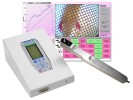Authors
A Matthey, Y Daali, F Curtin, et al
Lab
Division of Clinical Pharmacology and Toxicology, University Hospital of Geneva, Geneva, Switzerland.
Journal
European Journal of Pain
Abstract
The antihyperalgesic and sedative effects of the _2_subunit preferring GABAA positive allosteric modulator (GAM), N_desmethyl_clobazam (NDMC), 20 and 60 mg, were assessed in a randomized, placebo and active_controlled (clonazepam 1,5 mg), 4_way crossover study, in healthy volunteers, using the ultraviolet B_induced experimental pain model. Single (20, 40, 60 mg) and repeated doses (20 mg over 15 days) of NDMC pharmacokinetics were evaluated. Thirty_two subjects participated in the study. Primary outcome parameter was maximal change in the area of cutaneous UVB irradiation_induced secondary hyperalgesia (ASH). ASH decreased under all treatments. Mean (SD) relative change was 79 (22)%, 83 (24)%, 77 (30)% and 92 (16)% for placebo, NDMC20, NDMC60 and clonazepam, respectively. Neither absolute change nor relative change in ASH was significantly different between NDMC60 and placebo (mean difference = 2.3 cm2 [95% CI 4.0–8.5], p = .462 and 0.4% [_11.9 to 12.6], p = .952, respectively). An overall treatment effect was found on level of sedation. Compared to placebo, sedation was higher under clonazepam (mean difference = 39 mm [30–49] on a visual analogue scale, p < .001) while NDMC was free of sedative effect. NDMC pharmacokinetics after single doses showed poor absorption, but was linear. Steady_state plasma concentrations of NDMC20 were attained within 14 days, with low between_subjects variability. Mean steady_state concentration (CS_S, SD) reached 209 (22) ng/ml. NDMC absence of sedative effect and its overall well_characterized safety coming from years of utilization as a metabolite from clobazam, raise the prospect of dose escalating trials in patients to quantify its clinical utility.
BIOSEB Instruments Used:
Electronic Von Frey 4 (BIO-EVF4),Electronic Von Frey 5 with embedded camera (BIO-EVF5)

 Pain - Thermal Allodynia / Hyperalgesia
Pain - Thermal Allodynia / Hyperalgesia Pain - Spontaneous Pain - Postural Deficit
Pain - Spontaneous Pain - Postural Deficit Pain - Mechanical Allodynia / Hyperalgesia
Pain - Mechanical Allodynia / Hyperalgesia Learning/Memory - Attention - Addiction
Learning/Memory - Attention - Addiction Physiology & Respiratory Research
Physiology & Respiratory Research
 Pain
Pain Central Nervous System (CNS)
Central Nervous System (CNS) Neurodegeneration
Neurodegeneration Sensory system
Sensory system Motor control
Motor control Mood Disorders
Mood Disorders Other disorders
Other disorders Muscular system
Muscular system Joints
Joints Metabolism
Metabolism Cross-disciplinary subjects
Cross-disciplinary subjects Preclinical studies and opioids: role in crisis management in the United States
Preclinical studies and opioids: role in crisis management in the United States 
